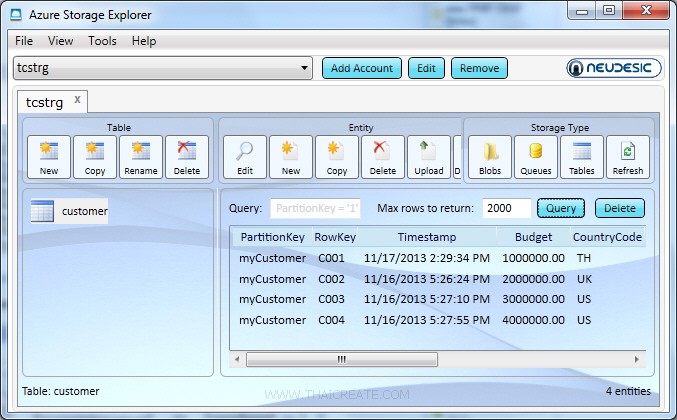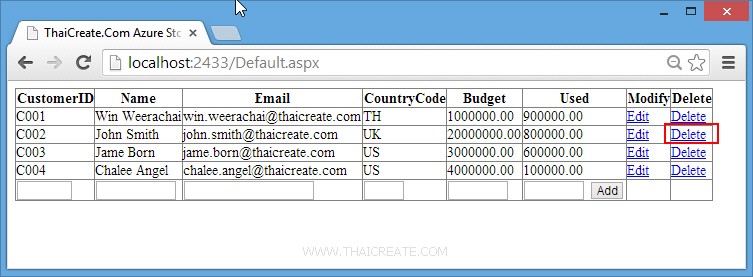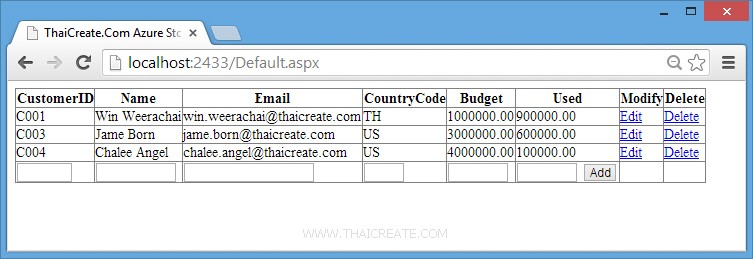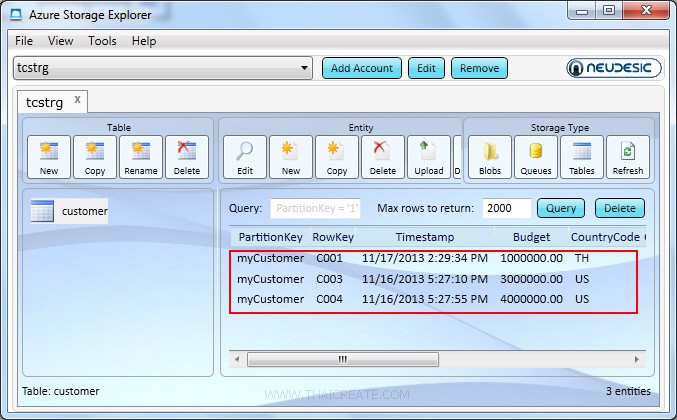ตอนที่ 11 : How to use .Net (Asp.net) Delete Entity in Table Storage - ลบข้อมูลในตาราง |
ตอนที่ 11 : How to use .Net (Asp.net) Delete Entity in Table Storage - ลบข้อมูลในตาราง บทความนี้เป็นตัวอย่างการใช้ .NET (ASP.Net ) เพื่อลบหรือ Delete ข้อมูลที่อยู่บน Table Storage ของ Windows Azure โดยจะยกตัวอย่างการแสดงข้อมูลใน Table Storage ออกมาเป็นตาราง และ สามารถเลือกที่จะลบ Delete รายการข้อมูลต่าง ๆ ตามต้องการ ตัวอย่างนี้ยังคงใช้ Jar Library ของ Windows Azure ซึ่งสามารถใช้งานและเขียนได้ด้วยคำสั่งที่ง่าย ๆ และสั้นมาก
 ข้อมูล Table Storage ที่อยู่บน Windows Azure
ข้อมูล Table Storage ที่อยู่บน Windows Azure
CustomerEntity.cs เป็น Model Class สำหรับการเชื่อมต่อกับ Table Storage
using System;
using System.Collections.Generic;
using System.Linq;
using System.Web;
using Microsoft.WindowsAzure.Storage.Table;
namespace myWebApp
{
public class CustomerEntity : TableEntity
{
public CustomerEntity(string pKey, string rKey)
{
this.PartitionKey = pKey;
this.RowKey = rKey;
}
public CustomerEntity() { }
public string CustomerID { get; set; }
public string Name { get; set; }
public string Email { get; set; }
public string CountryCode { get; set; }
public string Budget { get; set; }
public string Used { get; set; }
}
}
Syntax การ Delete
// Create the CloudTable object that represents the "customer" table.
CloudTable table = tableClient.GetTableReference("customer");
// Create a retrieve operation that expects a customer entity.
TableOperation retrieveOperation = TableOperation.Retrieve<CustomerEntity>("myCustomer", myGridView.DataKeys[e.RowIndex].Value.ToString());
// Execute the operation.
TableResult retrievedResult = table.Execute(retrieveOperation);
// Assign the result to a CustomerEntity.
CustomerEntity deleteEntity = (CustomerEntity)retrievedResult.Result;
// Create the Delete TableOperation.
if (deleteEntity != null)
{
TableOperation deleteOperation = TableOperation.Delete(deleteEntity);
// Execute the operation.
table.Execute(deleteOperation);
}
เป็นการ Delete ข้อมูลใน Table Storage ตามการ Filter ข้อมูลที่ต้องการ
Example เขียน .NET (ASP.Net) เพื่อ Delete ลบข้อมูล Table Storage บน Windows Azure
Default.aspx.cs
using System;
using System.Collections.Generic;
using System.Linq;
using System.Web;
using System.Web.UI;
using System.Web.UI.WebControls;
using Microsoft.WindowsAzure.Storage;
using Microsoft.WindowsAzure.Storage.Auth;
using Microsoft.WindowsAzure.Storage.Table;
namespace myWebApp
{
public partial class Default : System.Web.UI.Page
{
protected void Page_Load(object sender, EventArgs e)
{
if (!Page.IsPostBack)
{
BindData();
}
}
protected void BindData()
{
// Create the connectionstring
String StorageConnectionString = "DefaultEndpointsProtocol=https;AccountName=[yourAccount];AccountKey=[yourKey]";
// Retrieve storage account from connection string.
CloudStorageAccount storageAccount = CloudStorageAccount.Parse(StorageConnectionString);
// Create the table client.
CloudTableClient tableClient = storageAccount.CreateCloudTableClient();
// Create the CloudTable object that represents the "customer" table.
CloudTable table = tableClient.GetTableReference("customer");
// Construct the query operation for all customer entities where PartitionKey="Smith".
TableQuery<CustomerEntity> query = new TableQuery<CustomerEntity>().Where(TableQuery.GenerateFilterCondition("PartitionKey", QueryComparisons.Equal, "myCustomer"));
// Create List Customer
List<CustomerEntity> ls = new List<CustomerEntity>();
// Print the fields for each customer.
foreach (CustomerEntity entity in table.ExecuteQuery(query))
{
// Create a new customer entity.
CustomerEntity cus = new CustomerEntity(entity.PartitionKey, entity.RowKey);
cus.CustomerID = entity.CustomerID;
cus.Name = entity.Name;
cus.Email = entity.Email;
cus.CountryCode = entity.CountryCode;
cus.Budget = entity.Budget;
cus.Used = entity.Used;
ls.Add(cus);
}
// Bind Data to GridView
this.myGridView.DataSource = ls;
this.myGridView.DataBind();
}
protected void modDeleteCommand(Object sender, GridViewDeleteEventArgs e)
{
// Create the connectionstring
String StorageConnectionString = "DefaultEndpointsProtocol=https;AccountName=[yourAccount];AccountKey=[yourKey]";
// Retrieve storage account from connection string.
CloudStorageAccount storageAccount = CloudStorageAccount.Parse(StorageConnectionString);
// Create the table client.
CloudTableClient tableClient = storageAccount.CreateCloudTableClient();
// Create the CloudTable object that represents the "customer" table.
CloudTable table = tableClient.GetTableReference("customer");
// Create a retrieve operation that expects a customer entity.
TableOperation retrieveOperation = TableOperation.Retrieve<CustomerEntity>("myCustomer", myGridView.DataKeys[e.RowIndex].Value.ToString());
// Execute the operation.
TableResult retrievedResult = table.Execute(retrieveOperation);
// Assign the result to a CustomerEntity.
CustomerEntity deleteEntity = (CustomerEntity)retrievedResult.Result;
// Create the Delete TableOperation.
if (deleteEntity != null)
{
TableOperation deleteOperation = TableOperation.Delete(deleteEntity);
// Execute the operation.
table.Execute(deleteOperation);
}
myGridView.EditIndex = -1;
BindData();
}
}
}
Default.aspx
<%@ Page Language="C#" AutoEventWireup="true" CodeBehind="Default.aspx.cs" Inherits="myWebApp.Default" %>
<!DOCTYPE html>
<html xmlns="http://www.w3.org/1999/xhtml">
<head runat="server">
<title>ThaiCreate.Com Azure Storage Tutorial</title>
</head>
<body>
<form id="form1" runat="server">
<div>
<asp:GridView id="myGridView" runat="server" AutoGenerateColumns="False"
ShowFooter="True"
DataKeyNames="CustomerID"
ShowHeaderWhenEmpty ="true"
OnRowDeleting="modDeleteCommand">
<Columns>
<asp:TemplateField HeaderText="CustomerID">
<ItemTemplate>
<asp:Label id="lblCustomerID" runat="server" Text='<%# DataBinder.Eval(Container, "DataItem.CustomerID") %>'></asp:Label>
</ItemTemplate>
<EditItemTemplate>
<asp:TextBox id="txtEditCustomerID" size="5" runat="server" Text='<%# DataBinder.Eval(Container, "DataItem.CustomerID") %>'></asp:TextBox>
</EditItemTemplate>
<FooterTemplate>
<asp:TextBox id="txtAddCustomerID" size="5" runat="server"></asp:TextBox>
</FooterTemplate>
</asp:TemplateField>
<asp:TemplateField HeaderText="Name">
<ItemTemplate>
<asp:Label id="lblName" runat="server" Text='<%# DataBinder.Eval(Container, "DataItem.Name") %>'></asp:Label>
</ItemTemplate>
<EditItemTemplate>
<asp:TextBox id="txtEditName" size="10" runat="server" Text='<%# DataBinder.Eval(Container, "DataItem.Name") %>'></asp:TextBox>
</EditItemTemplate>
<FooterTemplate>
<asp:TextBox id="txtAddName" size="10" runat="server"></asp:TextBox>
</FooterTemplate>
</asp:TemplateField>
<asp:TemplateField HeaderText="Email">
<ItemTemplate>
<asp:Label id="lblEmail" runat="server" Text='<%# DataBinder.Eval(Container, "DataItem.Email") %>'></asp:Label>
</ItemTemplate>
<EditItemTemplate>
<asp:TextBox id="txtEditEmail" size="20" runat="server" Text='<%# DataBinder.Eval(Container, "DataItem.Email") %>'></asp:TextBox>
</EditItemTemplate>
<FooterTemplate>
<asp:TextBox id="txtAddEmail" size="20" runat="server"></asp:TextBox>
</FooterTemplate>
</asp:TemplateField>
<asp:TemplateField HeaderText="CountryCode">
<ItemTemplate>
<asp:Label id="lblCountryCode" runat="server" Text='<%# DataBinder.Eval(Container, "DataItem.CountryCode") %>'></asp:Label>
</ItemTemplate>
<EditItemTemplate>
<asp:TextBox id="txtEditCountryCode" size="2" runat="server" Text='<%# DataBinder.Eval(Container, "DataItem.CountryCode") %>'></asp:TextBox>
</EditItemTemplate>
<FooterTemplate>
<asp:TextBox id="txtAddCountryCode" size="2" runat="server"></asp:TextBox>
</FooterTemplate>
</asp:TemplateField>
<asp:TemplateField HeaderText="Budget">
<ItemTemplate>
<asp:Label id="lblBudget" runat="server" Text='<%# DataBinder.Eval(Container, "DataItem.Budget") %>'></asp:Label>
</ItemTemplate>
<EditItemTemplate>
<asp:TextBox id="txtEditBudget" size="6" runat="server" Text='<%# DataBinder.Eval(Container, "DataItem.Budget") %>'></asp:TextBox>
</EditItemTemplate>
<FooterTemplate>
<asp:TextBox id="txtAddBudget" size="6" runat="server"></asp:TextBox>
</FooterTemplate>
</asp:TemplateField>
<asp:TemplateField HeaderText="Used">
<ItemTemplate>
<asp:Label id="lblUsed" runat="server" Text='<%# DataBinder.Eval(Container, "DataItem.Used") %>'></asp:Label>
</ItemTemplate>
<EditItemTemplate>
<asp:TextBox id="txtEditUsed" size="6" runat="server" Text='<%# DataBinder.Eval(Container, "DataItem.Used") %>'></asp:TextBox>
</EditItemTemplate>
<FooterTemplate>
<asp:TextBox id="txtAddUsed" size="6" runat="server"></asp:TextBox>
<asp:Button id="btnAdd" runat="server" Text="Add" CommandName="Add"></asp:Button>
</FooterTemplate>
</asp:TemplateField>
<asp:CommandField ShowEditButton="True" CancelText="Cancel" DeleteText="Delete" EditText="Edit" UpdateText="Update" HeaderText="Modify" />
<asp:CommandField ShowDeleteButton="True" HeaderText="Delete" />
</Columns>
</asp:GridView>
</div>
</form>
</body>
</html>
Screenshot

แสดงรายการข้อมูลจาก Table Storage ให้เลือกรายการที่ต้องการ Delete

หลังจากลบแล้วข้อมูลจะหายไปทันที

เมื่อเข้าไปดูใน Table Storage บน Windows Azure ผ่านโปรแกรม Azure Storage Explorer ข้อมูลจะมีการลบ Delete ตามที่เราลบไปก่อนหน้านี้
บทความที่เกี่ยวข้อง
บทความถัดไปที่แนะนำให้อ่าน
|
 ช่วยกันสนับสนุนรักษาเว็บไซต์ความรู้แห่งนี้ไว้ด้วยการสนับสนุน Source Code 2.0 ของทีมงานไทยครีเอท ช่วยกันสนับสนุนรักษาเว็บไซต์ความรู้แห่งนี้ไว้ด้วยการสนับสนุน Source Code 2.0 ของทีมงานไทยครีเอท
|
|
| |
By : |
ThaiCreate.Com Team (บทความเป็นลิขสิทธิ์ของเว็บไทยครีเอทห้ามนำเผยแพร่ ณ เว็บไซต์อื่น ๆ) |
| |
Score Rating : |
  |
|
| |
Create/Update Date : |
2013-12-29 20:07:54 /
2017-03-24 15:18:21 |
| |
Download : |
No files |
|
|
Sponsored Links / Related |
|
|
|
|
|
|

|